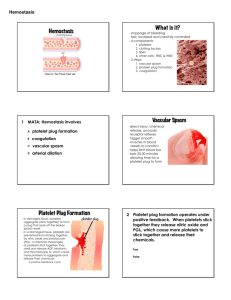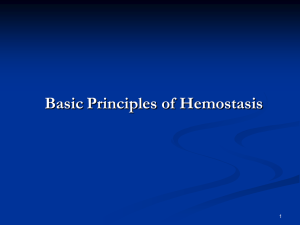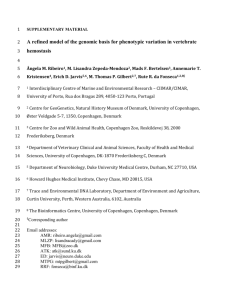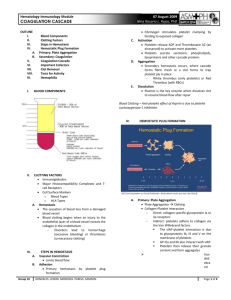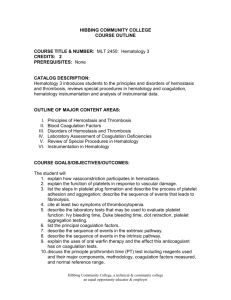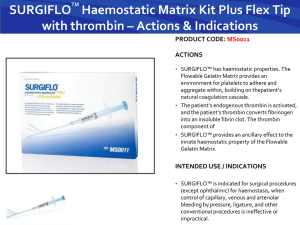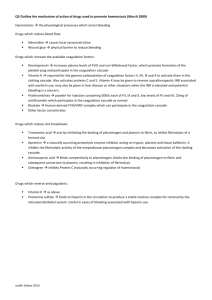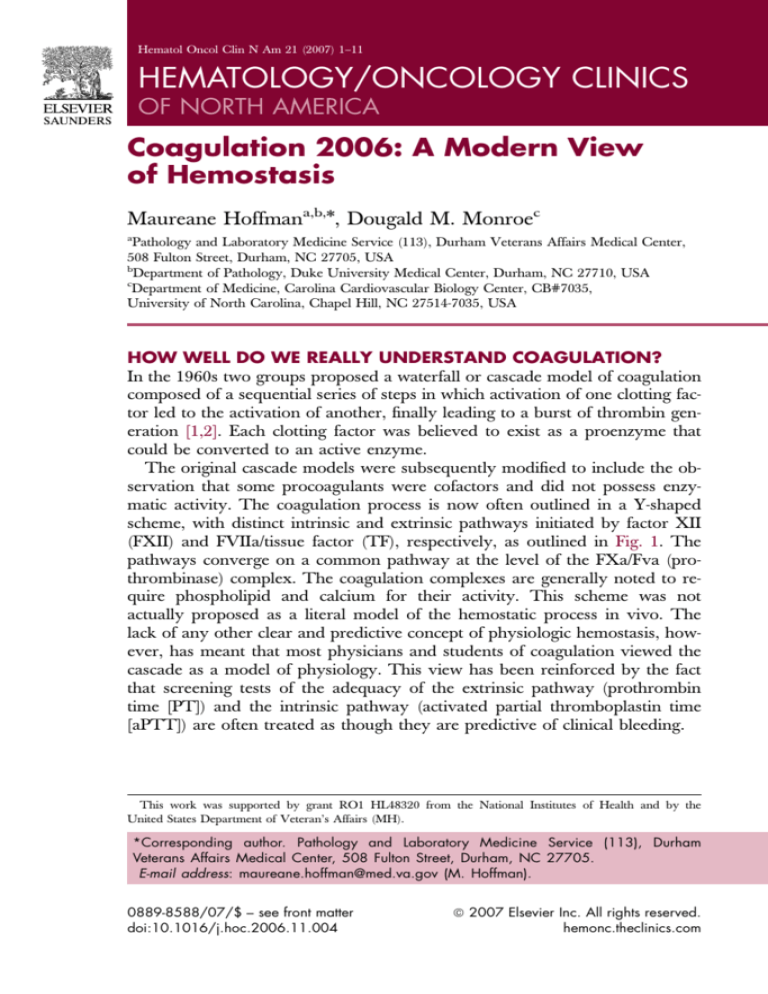
Hematol Oncol Clin N Am 21 (2007) 1–11
HEMATOLOGY/ONCOLOGY CLINICS
OF NORTH AMERICA
Coagulation 2006: A Modern View
of Hemostasis
Maureane Hoffmana,b,*, Dougald M. Monroec
a
Pathology and Laboratory Medicine Service (113), Durham Veterans Affairs Medical Center,
508 Fulton Street, Durham, NC 27705, USA
b
Department of Pathology, Duke University Medical Center, Durham, NC 27710, USA
c
Department of Medicine, Carolina Cardiovascular Biology Center, CB#7035,
University of North Carolina, Chapel Hill, NC 27514-7035, USA
HOW WELL DO WE REALLY UNDERSTAND COAGULATION?
In the 1960s two groups proposed a waterfall or cascade model of coagulation
composed of a sequential series of steps in which activation of one clotting factor led to the activation of another, finally leading to a burst of thrombin generation [1,2]. Each clotting factor was believed to exist as a proenzyme that
could be converted to an active enzyme.
The original cascade models were subsequently modified to include the observation that some procoagulants were cofactors and did not possess enzymatic activity. The coagulation process is now often outlined in a Y-shaped
scheme, with distinct intrinsic and extrinsic pathways initiated by factor XII
(FXII) and FVIIa/tissue factor (TF), respectively, as outlined in Fig. 1. The
pathways converge on a common pathway at the level of the FXa/Fva (prothrombinase) complex. The coagulation complexes are generally noted to require phospholipid and calcium for their activity. This scheme was not
actually proposed as a literal model of the hemostatic process in vivo. The
lack of any other clear and predictive concept of physiologic hemostasis, however, has meant that most physicians and students of coagulation viewed the
cascade as a model of physiology. This view has been reinforced by the fact
that screening tests of the adequacy of the extrinsic pathway (prothrombin
time [PT]) and the intrinsic pathway (activated partial thromboplastin time
[aPTT]) are often treated as though they are predictive of clinical bleeding.
This work was supported by grant RO1 HL48320 from the National Institutes of Health and by the
United States Department of Veteran’s Affairs (MH).
*Corresponding author. Pathology and Laboratory Medicine Service (113), Durham
Veterans Affairs Medical Center, 508 Fulton Street, Durham, NC 27705.
E-mail address: maureane.hoffman@med.va.gov (M. Hoffman).
0889-8588/07/$ – see front matter
doi:10.1016/j.hoc.2006.11.004
ª 2007 Elsevier Inc. All rights reserved.
hemonc.theclinics.com
2
HOFFMAN & MONROE
Fig. 1. The extrinsic and intrinsic pathways in the cascade model of coagulation. These two
pathways are conceived as each leading to formation of the factor Xa/Va complex, which
generates thrombin. Lipid indicates that the reaction requires a phospholipid surface. These
pathways are assayed clinically using the prothrombin time (PT) and activated partial thromboplastin time (aPTT), respectively. HK, high molecular weight kininogen; PK, prekallikrein.
Although the cascade concept of coagulation was treated as though it were
a model of coagulation in vivo, many people recognized that the intrinsic
and extrinsic systems could not operate in vivo as independent and redundant
pathways as implied by this model. It was clear that even though deficiencies of
each of the factors in the intrinsic pathway could have equally long aPTT
values, they had dramatically different risks of hemorrhage. Deficiencies of
FXII are not associated with significant hemorrhage, deficiencies of FXI might
or might not be associated with hemorrhage, but deficiencies of factors VIII
and IX are consistently associated with hemorrhage.
The key observation that the FVIIa/TF complex activated not only FX but
also FIX [3], suggested that the pathways were linked. Other important observations led to the conclusion that activity of the FVIIa/TF complex is the major
initiating event in hemostasis in vivo [4,5]. It was still not clear why an intact
extrinsic pathway could not compensate for the lack of FIX or VIII in hemophilia, however.
CAN AN EMPHASIS ON THE ROLE OF CELLS IMPROVE
OUR UNDERSTANDING OF COAGULATION?
It was recognized from the earliest studies of coagulation that cells were important participants in the coagulation process. Of course, it is clear that normal
hemostasis is not possible in the absence of platelets. In addition, TF is an integral membrane protein and thus its activity is normally associated with cells.
Because different cells express different levels of pro- and anticoagulant
A MODERN VIEW OF HEMOSTASIS
3
proteins and have different complements of receptors for components of hemostasis, it is logical that simply representing the cells involved in coagulation as
phospholipid vesicles may overlook the important contributions of cells in directing hemostasis in vivo. The authors’ studies in a cell-based experimental
model of coagulation [6–8] and the existing literature led us to propose [9]
that hemostasis actually occurs in a step-wise process, regulated by cellular
components in vivo, as outlined in the following sections.
Step 1: Initiation of Coagulation on TF-bearing Cells
The goal of hemostasis it to produce a platelet and fibrin plug to seal a site of
injury or rupture in the blood vessel wall. This process is initiated when TFbearing cells are exposed to blood at a site of injury.
TF is a transmembrane protein that acts as a receptor and cofactor for FVII.
Once bound to TF, zymogen FVII is rapidly converted to FVIIa through mechanisms not yet completely understood but possibly involving FXa or noncoagulation proteases. The resulting FVIIa/TF complex catalyzes activation of FX
and activation of FIX. The factors Xa and IXa formed on the TF-bearing cells
have distinct and separate functions in initiating blood coagulation [7]. The
FXa formed on the TF-bearing cell interacts with its cofactor Va to form prothrombinase complexes and generates a small amount of thrombin on the TF
cells (Fig. 2A). By contrast, the FIXa activated by FVIIa/TF does not act on the
TF-bearing cell and does not play a significant role in the initiation phase of coagulation. If an injury has occurred and platelets have adhered near the site of
the TF-bearing cells, the FIXa can diffuse to the surface of nearby activated
platelets. It can then bind to a specific platelet surface receptor [10], interact
with its cofactor, FVIIIa, and activate FX directly on the platelet surface.
Most of the coagulation factors can leave the vasculature and their activation
peptides are found in the lymph [11]. It is likely, therefore, that most (extravascular) TF is bound to FVIIa even in the absence of an injury, and that low
levels of FIXa, FXa, and thrombin are produced on TF-bearing cells at all
times. This process is kept separated from key components of hemostasis by
an intact vessel wall, however. The very large components of the coagulation
process are platelets and FVIII bound to multimeric von Willebrand factor
(vWF). These components normally only come into contact with the extravascular compartment when an injury disrupts the vessel wall. Platelets and FVIIIvWF then leave the vascular space and adhere to collagen and other matrix
components at the site of injury.
Step 2: Amplification of the Procoagulant Signal by Thrombin
Generated on the TF-bearing Cell
Binding of platelets to collagen or by way of vWF leads to partial platelet activation. The coagulation process is most effectively initiated, however, when
enough thrombin is generated on or near the TF-bearing cells to trigger full activation of platelets and activation of coagulation cofactors on the platelet surface in the amplification step (as illustrated in Fig. 2B). Although this amount of
thrombin may not be sufficient to clot fibrinogen, it is sufficient to initiate
4
HOFFMAN & MONROE
Fig. 2. Steps in a cell-based model of coagulation. (A) Initiation occurs on the TF-bearing cell
as activated FX combines with its cofactor, FVa, to activate small amounts of thrombin. (B) The
small amount of thrombin generated on the TF-bearing cell amplifies the procoagulant response by activating cofactors, factor XI, and platelets. (C) The large burst of thrombin required
for effective hemostasis is formed on the platelet surface during the propagation phase.
events that prime the clotting system for a subsequent burst of platelet surface
thrombin generation. Experiments using a cell-based model have shown that
minute amounts of thrombin are formed in the vicinity of TF-bearing cells
exposed to plasma concentrations of procoagulants, even in the absence of
platelets. The small amounts of FVa required for prothrombinase assembly
on TF-bearing cells are activated by FXa [12] or by noncoagulation proteases
A MODERN VIEW OF HEMOSTASIS
5
produced by the cells [13] or are released from platelet that adhere nearby. The
small amounts of thrombin generated on the TF-bearing cells are responsible
for [8,14]: (1) activating platelets, (2) activating FV, (3) activating FVIII and dissociating FVIII from VWF, and (4) activating FXI. The activity of the FXa
formed by the FVIIa/TF complex is restricted to the TF-bearing cell, because
FXa that dissociates from the cell surface is rapidly inhibited by TFPI or AT
in the fluid phase. In contrast to FXa, FIXa can diffuse to adjacent platelet surfaces because it is not inhibited by TFPI and is inhibited much more slowly by
AT than is FXa.
Step 3: Propagation of Thrombin Generation on the Platelet Surface
Platelets play a major role in localizing clotting reactions to the site of injury
because they adhere and aggregate at the sites of injury where TF is also exposed. They provide the primary surface for generation of the burst of thrombin needed for effective hemostasis during the propagation phase of
coagulation (Fig. 2C). Platelet localization and activation are mediated by
vWF, thrombin, platelet receptors, and vessel wall components, such as collagen [15].
Once platelets are activated, the cofactors Va and VIIIa are rapidly localized
on the platelet surface [6]. As noted above, the FIXa formed by the FVIIa/TF
complex can diffuse through the fluid phase and also bind to the surface of activated platelets. Likewise, FXI also binds to platelet surfaces and is activated
by the priming amount of thrombin [14,16], bypassing the need for FXIIa.
The platelet-bound FXIa can activate more FIX to IXa. Once the platelet tenase complex is assembled, FX from the plasma is activated to FXa on the
platelet surface. FXa then associates with FVa to support a burst of thrombin
generation of sufficient magnitude to produce a stable fibrin clot.
The large amount of thrombin generated on the platelet surface is responsible for stabilizing the hemostatic clot in more ways than just promoting fibrin
polymerization. In fact, most of the thrombin generated during the hemostatic
process is produced after the initial fibrin clot is formed. The platelet-produced
thrombin also stabilizes the clot by: (1) activating FXIII [17], (2) activating
TAFI [18], (3) cleaving the platelet PAR-4 receptor [19], and (4) being incorporated into the structure of the clot.
The role of FXI in hemostasis has been a point of some controversy, because
even severe FXI deficiency does not result in a hemorrhagic tendency comparable to that seen in severe FVIII or IX deficiency. This discrepancy can be explained if FXI is viewed as an enhancer or booster of thrombin generation.
FXIa activates additional FIXa on the platelet surface to supplement FIXa/
FVIIIa complex formation and enhance platelet surface FXa and thrombin generation. FXI thus is not essential for platelet-surface thrombin generation, as are
FIX and FVIII, and its deficiency does not compromise hemostasis to the degree seen in FIX and FVIII deficiency.
Our knowledge of the platelet contribution to thrombin generation continues to evolve. There is evidence that there is more than one population
6
HOFFMAN & MONROE
of activated platelets, one of which has been referred to as COAT (COllagen
And Thrombin stimulated) platelets [20]. These platelets have enhanced
thrombin-generating ability because of enhanced binding of both tenase and
prothrombinase component [21,22]. The in vivo relevance of these findings
is not yet clear, but it may be that the greatest procoagulant activity is generated on platelets that have bound to collagen matrix and also been exposed to
thrombin. Once the exposed collagen matrix is covered by a platelet/fibrin
layer, additional platelets that accumulate are not activated to the COAT state,
thus tending to damp down the procoagulant signal as the area of the wound is
occluded by a hemostatic clot.
Although each step of the cell-based model has been depicted as an isolated
set of reactions, including initiation, amplification, and propagation, they
should be viewed as an overlapping continuum of events. For example, thrombin produced on the platelet surface early in the propagation phase may initially cleave substrates on the platelet surface and continue to amplify the
procoagulant response, in addition to leaving the platelet and promoting fibrin
assembly.
The cell-based model of coagulation shows us that the extrinsic and intrinsic
pathways are not redundant. Let us consider the extrinsic pathway to consist of
the FVIIa/TF complex working with the FXa/Va complex and the intrinsic
pathway to consist of FXIa working with the complexes of factors VIIIa/IXa
and factors Xa/Va as illustrated in Fig. 3 (from Ref. [23]). The extrinsic pathway operates on the TF-bearing cell to initiate and amplify coagulation. By contrast, the intrinsic pathway operates on the activated platelet surface to produce
the burst of thrombin that causes formation and stabilization of the fibrin clot.
FIBRINOLYSIS
Even as the fibrin clot is being formed in the body, the fibrinolytic system is
being initiated to disrupt it. The final effector of the fibrinolytic system is plasmin, which cleaves fibrin into soluble degradation products. Plasmin is produced from the inactive precursor plasminogen by the action of two
plasminogen activators: urokinase-type plasminogen activator (uPA) and tissue-type plasminogen activator (tPA). The PAs are in turn regulated by plasminogen activator inhibitors (PAIs). Plasminogen is found at a much higher
plasma concentration than the PAs. The availability of the two PAs in the
plasma therefore generally determines the extent of plasmin formation. tPA release from endothelial cells is provoked by thrombin and venous occlusion
[24]. tPA and plasminogen both bind to the evolving fibrin polymer. Once plasminogen is activated to plasmin it cleaves fibrin at specific lysine and arginine
residues, resulting in dissolution of the fibrin clot.
Thrombin-activatable inhibitor of fibrinolysis (TAFI) is a zymogen that can
be activated (TAFIa) by thrombin or plasmin [18]. As fibrin is degraded by
plasmin, C-terminal lysines are exposed that enhance activation of additional
plasminogen to plasmin. TAFIa removes the C-terminal lysines from fibrin
and thereby inhibits the cofactor activity of fibrin for plasminogen activation.
A MODERN VIEW OF HEMOSTASIS
7
Fig. 3. The extrinsic and intrinsic pathways in the cell-based model of coagulation. The role of
the cell-based extrinsic pathway (top) is to act on the TF-bearing cell to generate the small
amounts of thrombin (factor IIa) involved in initiating coagulation. The role of the cell-based intrinsic pathway (bottom) is to act on the platelet surface to generate the burst of thrombin
needed to form a stable fibrin clot. TF, tissue factor.
Fibrinolysis is essential for removal of clots during the process of wound
healing and for removing intravascular clots that might otherwise be manifest
as thrombosis. Intravascular deposition of fibrin is also associated with the development of atherosclerosis. An effective fibrinolytic system therefore tends to
protect against the chronic process of atherosclerotic vascular disease and the
acute process of thrombosis. Conversely, defects of fibrinolysis increase the
risk for atherothrombotic disease. For example, elevated levels of plasminogen
activator inhibitor-1, an inhibitor of fibrinolysis, are associated with an increased risk for atherosclerosis and thrombosis [25] as are decreased levels of
plasminogen [26]. The effectiveness of hemostasis in vivo depends not only
on the procoagulant reactions but also on the fibrinolytic process.
WHAT DOES ALL THIS MEAN FOR CLINICAL LABORATORY
TESTING?
It should be clear from the preceding discussion that our commonly used clinical coagulation tests do not really reflect the complexity of hemostasis in vivo.
8
HOFFMAN & MONROE
That does not mean that the PT and aPTT are useless. We just need to understand what they can and cannot tell us. These screening coagulation tests are
abnormal when there is a deficiency of one or more of the soluble coagulation
factors. They do not tell us what the risk for clinical bleeding will be. Two patients who have identical aPTT values can have drastically different risks of
hemorrhage. All of our common coagulation tests including the PT, aPTT,
thrombin clotting time, fibrinogen levels, and coagulation factor levels tell us
something about the plasma level of soluble factors required for hemostasis.
Their clinical implications must be evaluated by the ordering physician. Just because the PT and aPTT are within the normal range it does not follow that the
patient is at no risk for bleeding. Conversely, a mild elevation in these clotting
times does not mean that the patient is at risk for bleeding after an invasive
procedure.
Many whole blood coagulation tests are jockeying for position as a means of
evaluating overall hemostatic status in selected clinical settings. Although
whole blood tests have the advantage that they may reflect the contributions
of platelets to the hemostatic process, they still do not reflect the contributions
of the TF-bearing cells and local tissue conditions. Any laboratory test requires
skilled interpretation and clinical correlation in evaluating the true risk for
bleeding.
WHAT CAUSES BLEEDING IN PREVIOUSLY NORMAL
PATIENTS?
Many patients who experience significant hemorrhage do not have an underlying bleeding tendency that can be identified before a bleeding episode. Bleeding following surgical or accidental trauma or during a medical illness is often
associated with the development of an acquired coagulopathy. The hallmark of
coagulopathy is microvascular bleeding, which means oozing from cut surfaces
and minor sites of trauma, such as needle sticks. Microvascular bleeding can
lead to massive blood loss.
Causes of coagulopathic bleeding include consumption of coagulation factors
and platelets, excessive fibrinolysis, hypothermia, and acidosis.
Consumption of Coagulation Components
We normally think of disseminated intravascular coagulation (DIC) when we
talk of consumption. Clotting factors and platelets can also be consumed during
appropriate physiologic attempts at hemostasis, however. In this case it is appropriate to replace the depleted factors with transfusion therapy.
DIC can be much more complicated to manage [27]. The mainstay of treatment is to treat the underlying disorder, such as sepsis. In early or mild/compensated DIC administration of low-dose heparin may be considered to control
the procoagulant response to inflammation, infection, or malignancy. In more
severe or advanced DIC, however, replacement therapy may be necessary to
treat the bleeding tendency associated with depletion of coagulation factors
and platelets.
A MODERN VIEW OF HEMOSTASIS
9
Excessive Fibrinolysis
The process of fibrinolysis is initiated whenever coagulation is initiated. When
attempts at hemostasis are unsuccessful, a significant amount of fibrinolytic activity may still be generated and thwart subsequent efforts at hemostasis. Fibrinolytic inhibitors have thus proven to be useful in some circumstances.
Hypothermia
Many patients become hypothermic during medical illness or following surgical or accidental trauma [28]. Hypothermia can directly interfere with the hemostatic process by slowing the activity of coagulation enzymes. Less well
recognized is the finding that platelet adhesion and aggregation is impaired
even in mild hypothermia [29]. In hypothermic coagulopathic patients, raising
the core temperature can have a beneficial effect on bleeding by improving
platelet function and coagulation enzyme activity.
Acidosis
Acidosis can have an even more profound effect on procoagulant function than
hypothermia, although the two metabolic abnormalities often coexist. A drop
in the pH from 7.4 to 7.2 reduces the activity of each of the coagulation proteases by more than half [30]. Acidosis should be considered as a possible contributor to coagulopathic bleeding in medical and surgical patients.
WHAT HAPPENS AFTER THE BLEEDING STOPS?
Once hemostasis is completed the process of wound healing can begin. The hemostatic plug must be stable enough to maintain hemostasis, yet be removed as
the tissue defect is permanently closed. Fibrinolysis is accomplished by the action of plasmin, probably in concert with other leukocyte proteases. The neutrophils that initially accumulate at a site of injury are replaced over the course
of a few days with macrophages that engulf and degrade cellular debris and
components of the fibrin clot. The macrophages also secrete cytokines and
growth factors that facilitate the migration of fibroblasts and endothelial cells
into the wound site. In the case of a skin wound, the dermis is replaced by
highly cellular and vascular granulation tissue, while the surface epithelium
proliferates and migrates from the margins to cover the surface of the wound.
Many of the activities involved in wound healing are influenced by thrombin.
Thrombin plays a major role in platelet activation and degranulation. Several
key cytokines modulating wound healing are released from activated platelets,
including transforming growth factor beta (TGFb1) and platelet-derived
growth factor (PDGF). The amount and rate of thrombin generated during hemostasis influences the initial structure of the fibrin clot—the framework on
which cell migration takes place. In addition, thrombin has chemotactic and mitogenic activities for macrophages, fibroblasts, smooth muscle cells and endothelial cells. Generation of the right amount of thrombin during the
coagulation process not only may be essential for effective hemostasis but
also may set the stage for effective wound healing.
10
HOFFMAN & MONROE
References
[1] Macfarlane RG. An enzyme cascade in the blood clotting mechanism, and its function as
a biological amplifier. Nature 1964;202:498–9.
[2] Davie EW, Ratnoff OD. Waterfall sequence for intrinsic blood clotting. Science 1964;145:
1310–2.
[3] Østerud B, Rapaport SI. Activation of factor IX by the reaction product of tissue factor and
factor VII: additional pathway for initiating blood coagulation. Proc Natl Acad Sci U S A
1977;74:5260–4.
[4] Nemerson Y, Esnouf MP. Activation of a proteolytic system by a membrane lipoprotein:
mechanism of action of tissue factor. Proc Natl Acad Sci U S A 1973;70:310–4.
[5] Nemerson Y. The tissue factor pathway of blood coagulation. Semin Hematol 1992;29:
170–6.
[6] Monroe DM, Roberts HR, Hoffman M. Platelet procoagulant complex assembly in a tissue
factor-initiated system. Br J Haematol 1994;88:364–71.
[7] Hoffman M, Monroe DM, Oliver JA, et al. Factors IXa and Xa play distinct roles in tissue factor-dependent initiation of coagulation. Blood 1995;86:1794–801.
[8] Monroe DM, Hoffman M, Roberts HR. Transmission of a procoagulant signal from tissue factor-bearing cell to platelets. Blood Coagul Fibrinolysis 1996;7:459–64.
[9] Hoffman M, Monroe DM 3rd. A cell-based model of hemostasis. Thromb Haemost
2001;85:958–65.
[10] Rawala-Sheikh R, Ahmad SS, Monroe DM, et al. Role of gamma-carboxyglutamic acid residues in the binding of factor IXa to platelets and in factor-X activation. Blood 1992;79:
398–405.
[11] Le D, Borgs P, Toneff T, et al. Hemostatic factors in rabbit limb lymph: relationship to mechanisms regulating extravascular coagulation. Am J Physiol 1998;274:H769–76.
[12] Monkovic DD, Tracy PB. Activation of human factor V by factor Xa and thrombin. Biochemistry 1990;29:1118–28.
[13] Allen DH, Tracy PB. Human coagulation factor V is activated to the functional cofactor by
elastase and cathepsin G expressed at the monocyte surface. J Biol Chem 1995;270:
1408–15.
[14] Oliver J, Monroe D, Roberts H, et al. Thrombin activates factor XI on activated platelets in the
absence of factor XII. Arterioscler Thromb Vasc Biol 1999;19:170–7.
[15] Falati S, Gross P, Merrill-Skoloff G, et al. Real-time in vivo imaging of platelets, tissue factor
and fibrin during arterial thrombus formation in the mouse. Nat Med 2002;8:1175–81.
[16] Baglia FA, Walsh PN. Prothrombin is a cofactor for the binding of factor XI to the platelet
surface and for platelet-mediated factor XI activation by thrombin. Biochemistry
1998;37:2271–81.
[17] Lorand L. Factor XIII: structure, activation, and interactions with fibrinogen and fibrin. Ann N
Y Acad Sci 2001;936:291–311.
[18] Bajzar L, Manuel R, Nesheim ME. Purification and characterization of TAFI, a thrombinactivable fibrinolysis inhibitor. J Biol Chem 1995;270:14477–84.
[19] Ofosu FA. Protease activated receptors 1 and 4 govern the responses of human platelets to
thrombin. Transfus Apher Sci 2003;28:265–8.
[20] Alberio L, Safa O, Clemetson KJ, et al. Surface expression and functional characterization
of alpha-granule factor V in human platelets: effects of ionophore A23187, thrombin, collagen, and convulxin. Blood 2000;95:1694–702.
[21] Dale GL, Friese P, Batar P, et al. Stimulated platelets use serotonin to enhance their retention
of procoagulant proteins on the cell surface. Nature 2002;415:175–9.
[22] Kempton CL, Hoffman M, Roberts HR, et al. Platelet heterogeneity: variation in coagulation
complexes on platelet subpopulations. Arterioscler Thromb Vasc Biol 2005;25:861–6.
[23] Hoffman M, Monroe DM. Rethinking the coagulation cascade. Curr Hematol Rep 2005;4:
391–6.
A MODERN VIEW OF HEMOSTASIS
11
[24] Szymanski LM, Pate RR, Durstine JL. Effects of maximal exercise and venous occlusion on
fibrinolytic activity in physically active and inactive men. J Appl Physiol 1994;77:2305–10.
[25] Huber K, Christ G, Wojta J, et al. Plasminogen activator inhibitor type-1 in cardiovascular
disease. Status report 2001. Thromb Res 2001;103(Suppl 1):S7–19.
[26] Xiao Q, Danton MJ, Witte DP, et al. Plasminogen deficiency accelerates vessel wall disease
in mice predisposed to atherosclerosis. Proc Natl Acad Sci U S A 1997;94:10335–40.
[27] Mueller MM, Bomke B, Seifried E. Fresh frozen plasma in patients with disseminated intravascular coagulation or in patients with liver diseases. Thromb Res 2002;107(Suppl 1):
S9–17.
[28] Eddy VA, Morris JA Jr, Cullinane DC. Hypothermia, coagulopathy, and acidosis. Surg Clin
North Am 2000;80:845–54.
[29] Wolberg AS, Meng ZH, Monroe DM 3rd, et al. A systematic evaluation of the effect of temperature on coagulation enzyme activity and platelet function. J Trauma 2004;56:1221–8.
[30] Meng ZH, Wolberg AS, Monroe DM 3rd, et al. The effect of temperature and pH on the activity of factor VIIa: implications for the efficacy of high-dose factor VIIa in hypothermic and
acidotic patients. J Trauma 2003;55:886–91.


